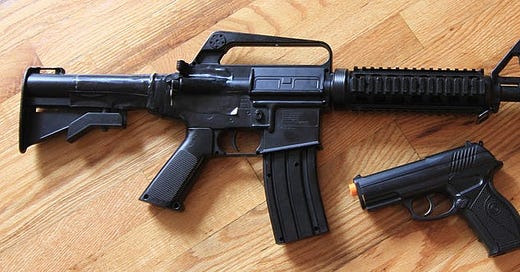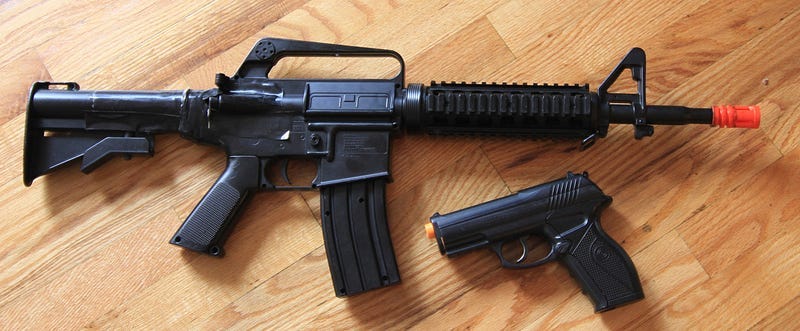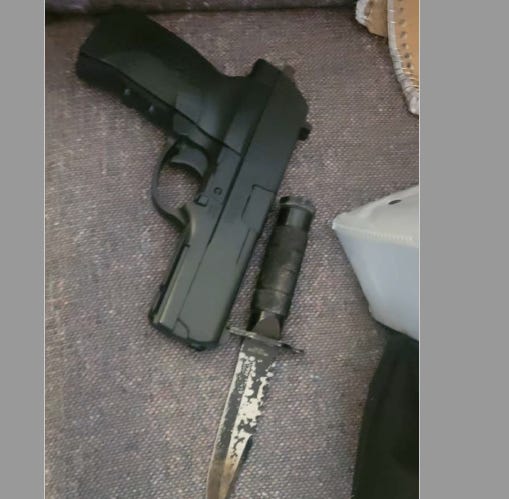Toy Guns and School Shooting Statistics
Should only “real guns” be included in school shooting reporting and statistics? There have been tragic incidents involving toy guns too.
Devastating update on the Wisconsin "active shooter" this week: The 14-year-old fatally shot by police at Mount Horeb Middle School was holding an air rifle that's available from Walmart, Amazon, and dozens of other retailers.
Police got calls for someone with a rifle on campus. When officers told the teen to drop the gun, he didn't comply with commands and was fatally shot.
There are 2,000 high school air rifle programs across the United States and NCAA college air rifle teams. In Wisconsin, the 4H and American Legion sponsor teen air rifle competitions.
No information is available yet about why the teen had the air rifle on campus.
"Toy guns" that look like real guns put armed school staff and police into an impossible situation. If they hesitate, they could be allowing a school shooting to start. If they shoot first and ask question later, a kid with an air rifle gets killed.
This is the right time to look back at my article from six years ago about why air rifles are included in the K-12 School Shooting Database.
Original article from December 2018:
Should only “real guns” be included in school shooting reporting and statistics? By real guns, I mean textbook defined firearms rather than “toys” like BB, pellet, or airsoft. The inclusion of these toy guns in the K-12 School Shooting Database has been debated by Reddit users after recent articles by The Guardian, Slate, VOX, Yahoo!, and the Sandy Hook Promise Press Release cited 2018 as a record year for school shootings.
The argument in response to the data’s publication is that school shooting statistics are being manipulated and elevated by including incidents that do not involve “real guns” in the data.
One could argue that only “real guns” are the only truly lethal weapons so statistics are skewed if a pellet gun fired at a student in a school is included. While a shot from the pellet gun itself may not be lethal, courts across the country have determined that use of deadly force is justified by officers confronting someone with a “toy” weapon. Dozens of court rulings have involved police officers firing at a suspect holding a toy weapon. In these cases, the courts have ruled that the officer “perceiving” a threat justifies the use of deadly force.
Creating a reliable data set hinges on determining the inclusion and exclusion criteria. This decision can be made by the data collector or the end user. If the data collector decides to exclude something, that information is not available to any other users, making the entire data set subject to any biases of the research team. Authors of future studies citing this data have the option to determine their own exclusion criteria which suits their own research objectives.
To provide useful, objective data for a broad audience, it is best to include as much information as possible. Doing so lets the user determine what they want to filter out based on the focus of their own interests. In the case of the K-12 School Shooting Database, we decided to include all types of firearms — real guns and toy guns — because of the consequences of using them can create circumstances that are similar to incidents with traditional firearms.
By publishing a detailed research methodology with the raw data set, any user can understand what information was collected and why it was included. This feature of the data set enables a user to make their own decision on what to include or exclude from their own analysis.
Deadly Consequences of “Toy” Guns in Schools
Aside from the debate of research methodology, pellet guns and other toy weapons have indeed caused loss of life in schools. Examples of these fatal toy gun incidents in the data set occurred before 2018 (the year that is in question for elevated statistics).
Ingraham High School
November 8, 2022 — Seattle, WA
Incident Summary: Prior to fatally shooting a 17-year-old classmate in the school hallway, the 14-year-old shooter had been suspended for carrying a replica BB gun at school. One staff member texted another ‘can’t we just expel [student]”.
Analysis: Carrying the replica BB gun was a warning that the teen had violent intent but did not have the capability to obtain a more deadly firearm.
Milwee Middle School
January 13, 2006 — Longwood, FL
Incident Summary: A student shooter brought a pellet gun to school and pointed it at another student in the classroom. The two students were involved in a dispute over a girl. There was a planned fight that was going to take place after school. The other student didn’t believe it was a real weapon and started wrestling with the shooter. The gun was knocked away and the shooter ran out of the classroom with it. The shooter would not put down the gun when confronted by police and he was shot in the head.
Analysis: The shooter was fatally shot by police because they determined the pellet gun to be a dangerous weapon justifying use of deadly force. A similar outcome would have likely happened with a “real gun” versus a pellet gun.
Grover Cleveland Elementary School
January 29, 1979 — San Diego, CA
Incident Summary: 3 killed, 8 injured. A non-student shooter lived across the street from the school and fired at random students and school staff waiting outside for the school to open. When police arrived, she shot an officer in the neck. The shooter then barricaded herself inside her house from multiple hours. She said her motive was “she didn’t like Mondays and wanted to liven things up”. The shooter had previously been arrested for firing BB gun at the school building breaking windows.
Analysis: The shooter’s initial incident with the BB gun was a precursor to the mass shooting that occurred at the same school.
Oak Haven Elementary School
May 23, 2007 — Coventry, RI
Incident Summary: A 13YOM (victim) on the playground of Oak Haven Elementary School was approached by an 11YOM (shooter) carrying a BB gun. The victim had been bullying the shooter. The 11YOM fired BBs at the victim striking him in the left hand, stomach, and chest.
Analysis: The shooter had the intent to kill the bully but did not have the capability to do so. The circumstances and warning signs of this incident would be the same as those of a fatal attack with a real firearm making this an important case to record for broader analysis of the subject.
These are just three examples of how the circumstances of a school shooting involving pellet, BB, or airsoft guns support their inclusion in a database designed to allow objective trend analysis of aggregate data. These incidents had similar circumstances to ones involving traditional firearms, making them useful data points for understanding and analysis of the problem.
For users who still feel that this data is not valuable, it can be easily filtered out by sorting “firearm type” and excluding these “toy” weapons categorized as “other” from the data (shown above).
David Riedman is the creator of the K-12 School Shooting Database and a national expert on school shootings. Listen to my recent interviews on Freakonomics Radio, New England Journal of Medicine, and Iowa Public Radio the day after the Perry High shooting.










